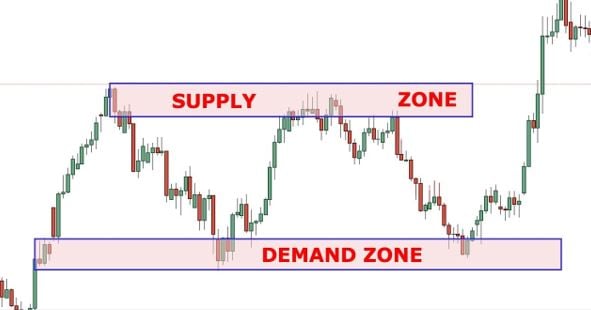Understanding supply and demand forex is a key aspect of technical analysis in trading. These zones represent areas on a price chart where the balance between buying and selling pressure shifts, leading to potential trading opportunities. In this comprehensive guide, we will explore different methods and techniques to identify and utilize supply and demand zones effectively in your trading strategy.
Table of Contents
Methods And Techniques To Utilize Supply And Demand Zones
Utilizing supply and demand zones in your trading strategy offers several benefits. They provide clear areas of potential market turning points, allowing for more precise entry and exit points. Supply and demand zones also help identify areas of imbalance between buyers and sellers, aiding in risk assessment and trade management. Additionally, incorporating supply and demand analysis enhances overall technical analysis skills, leading to improved trading decisions and increased profitability.
Steps to Utilize Supply and Demand Zones Effectively
1. Identify Swing Highs and Lows:
To locate potential supply and demand zones, start by identifying swing highs and lows on your price chart. Swing highs are peaks where the price has temporarily stopped rising and reversed, while swing lows are troughs where the price has temporarily halted its decline. These swing points often act as significant areas of supply and demand.
2. Draw Trendlines and Channels:
Drawing trendlines and channels can help identify areas of supply and demand. Connect swing highs to form a downward trendline and swing lows to create an upward trendline. These lines can act as boundaries for supply and demand zones. Additionally, drawing channels around price movements can provide further insight into potential areas of supply and demand.
3. Use Support and Resistance Levels:
Support and resistance levels are key indicators of supply and demand zones. Support levels are price levels where buying is strong enough to keep away the price from falling further, indicating potential demand zones. Resistance levels, on the other hand, are price levels where selling pressure is strong enough to prevent the price from rising higher, indicating potential supply zones. Identify these levels through historical price data and observe how the market reacts when the price approaches them.
4. Analyze Volume and Liquidity:
Volume and liquidity can provide important clues about supply and demand zones. Higher trading volumes often indicate significant buying or selling activity, suggesting the presence of a demand or supply zone, respectively. Thomas Wettermann suggests looking for volume spikes and analyzing how price responds to these levels. Higher liquidity can also contribute to the strength of supply and demand zones.
Apply Price Patterns:
Price patterns, such as double tops, double bottoms, head and shoulders, and triangles, can offer insights into potential supply and demand zones. These patterns often indicate market reversals or pauses in trends, highlighting areas of imbalance between supply and demand. Learn to recognize these patterns and combine them with other indicators to identify zones of interest.
5. Consider Fibonacci Retracement Levels:
Fibonacci retracement levels can help identify potential supply and demand zones within a broader trend. These levels are derived from Fibonacci ratios and tell areas where the price is likely to experience a temporary pullback or reversal. Look for confluence between Fibonacci retracement levels and other supply and demand indicators to pinpoint high-probability zones.
6. Utilize Moving Averages:
Moving averages can assist in identifying supply and demand zones by acting as dynamic support and resistance levels. Price often reacts near moving averages, providing potential zones for entry or exit. Experiment with different time periods for moving averages and observe how price interacts with these levels.
7. Backtest and Validate:
Once you have identified potential supply and demand zones, it is crucial to backtest and validate them using historical price data. Assess how price reacts to these zones, observe the effectiveness of your entries and exits, and refine your approach accordingly. Regularly review and adapt your strategies to improve accuracy and consistency.
Conclusion:
Mastering the identification and utilization of supply and demand zones can greatly enhance your trading strategy. By incorporating swing points, trendlines, support and resistance levels, volume analysis, price patterns, Fibonacci retracement levels, moving averages, and rigorous backtesting, you can improve your ability to identify and capitalize on supply and demand zones. Explore more, about proper risk management and combining supply and demand analysis with other technical and fundamental tools for successful trading.
Also Read: https://dailyfootballnews.org/unlocking-forex-potential-leveraging-crypto-signal-telegram/
